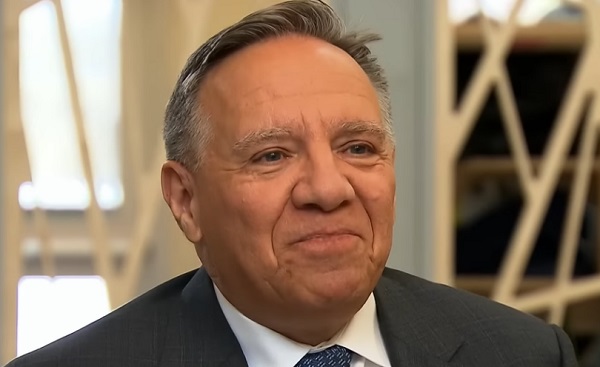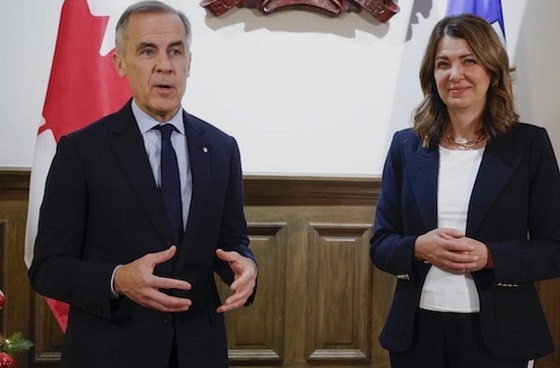National
New Quebec bill would prohibit teachers, school staff from wearing a crucifix

From LifeSiteNews
‘In Quebec, we made the decision that the state and the religions are separate and today we say the schools, the public schools are separate from religion’
The Canadian province of Quebec is moving ahead to expand its so-called religious symbols ban to now include all school staff, meaning no one who works at a school would be allowed to wear crucifixes or crosses of any kind.
On March 20, the Quebec provincial government of Premier François Legault tabled a bill which, if passed, would expand the province’s current religious symbols ban to stop “any religious indoctrination.”
“In Quebec, we made the decision that the state and the religions are separate and today we say the schools, the public schools are separate from religion,” said Minister of Education Bernard Drainville to reporters Thursday.
The new bill would update Quebec’s Education Act and would mandate that all students and staff at schools have their faces uncovered. It would also mandate teachers submit all of their educational plans to school principals so that they could be evaluated each year.
According to Drainville, the “idea” of the new bill is “to protect students from any religious indoctrination.”
He said, “If we are going to be coherent with this idea that a figure of authority should not wear a religious symbol, well, any adult can be a figure of authority and therefore no adults who are working within the school system should be allowed to wear a religious symbol.”
The Chair of the English Montreal School Board, Joe Ortona, blasted the bill as “a smokescreen for this government who’s sinking in the polls to try to show that they’re doing something.”
“And again, they’re not. They’re just coming up with phony solutions that really play to their base, which seems to be intolerant of any mention or of any public display of any religion whatsoever,” he added.
The announcement of the new proposed law comes after Premier François Legault in December of 2024 tasked his top cabinet officials with putting in place a law that would ban all praying in public in Canada’s only historically and culturally Catholic province.
“Seeing people praying in the streets, in public parks, is not something we want in Quebec,” Legault said at the time.
In 2019, Quebec passed its so-called secularism law, or Bill 21, that bans all public servants, public school teachers, police officers, government lawyers, and wildlife officials from wearing any religious symbols while at work, including crosses or crucifixes.
The province’s highest court upheld the law earlier this year after an appeal to overturn it failed.
Canada’s notwithstanding clause, which is in section 33 of the Canadian Charter of Rights and Freedoms, allows provinces to temporarily override sections of the Charter of Rights and Freedoms to protect new laws from being scrapped by the courts.
Canada’s leading constitutional freedom group, the Justice Centre for Constitutional Freedoms (JCCF), late last year sent a “demand letter” to Legault regarding his plan to ban public prayer.
“Such a ban is a totalitarian suppression of the freedoms of expression and of conscience and religion,” the JCCF said regarding its notice of sending the demand letter.
Quebec has been historically a Catholic province, however, since Vatican II, Mass attendance has plummeted and the provinces birth rate has nosedived to all-time lows. The province also has high abortion and euthanasia numbers, indicating a serious departure from the practice of the Catholic faith.
Alberta
IEA peak-oil reversal gives Alberta long-term leverage

This article supplied by Troy Media.
The peak-oil narrative has collapsed, and the IEA’s U-turn marks a major strategic win for Alberta
After years of confidently predicting that global oil demand was on the verge of collapsing, the International Energy Agency (IEA) has now reversed course—a stunning retreat that shatters the peak-oil narrative and rewrites the outlook for oil-producing regions such as Alberta.
For years, analysts warned that an oil glut was coming. Suddenly, the tide has turned. The Paris-based IEA, the world’s most influential energy forecasting body, is stepping back from its long-held view that peak oil demand is just around the corner.
The IEA reversal is a strategic boost for Alberta and a political complication for Ottawa, which now has to reconcile its climate commitments with a global outlook that no longer supports a rapid decline in fossil fuel use or the doomsday narrative Ottawa has relied on to advance its climate agenda.
Alberta’s economy remains tied to long-term global demand for reliable, conventional energy. The province produces roughly 80 per cent of Canada’s oil and depends on resource revenues to fund a significant share of its provincial budget. The sector also plays a central role in the national economy, supporting hundreds of thousands of jobs and contributing close to 10 per cent of Canada’s GDP when related industries are included.
That reality stands in sharp contrast to Ottawa. Prime Minister Mark Carney has long championed net-zero timelines, ESG frameworks and tighter climate policy, and has repeatedly signalled that expanding long-term oil production is not part of his economic vision. The new IEA outlook bolsters Alberta’s position far more than it aligns with his government’s preferred direction.
Globally, the shift is even clearer. The IEA’s latest World Energy Outlook, released on Nov. 12, makes the reversal unmistakable. Under existing policies and regulations, global demand for oil and natural gas will continue to rise well past this decade and could keep climbing until 2050. Demand reaches 105 million barrels per day in 2035 and 113 million barrels per day in 2050, up from 100 million barrels per day last year, a direct contradiction of years of claims that the world was on the cusp of phasing out fossil fuels.
A key factor is the slowing pace of electric vehicle adoption, driven by weakening policy support outside China and Europe. The IEA now expects the share of electric vehicles in global car sales to plateau after 2035. In many countries, subsidies are being reduced, purchase incentives are ending and charging-infrastructure goals are slipping. Without coercive policy intervention, electric vehicle adoption will not accelerate fast enough to meaningfully cut oil demand.
The IEA’s own outlook now shows it wasn’t merely off in its forecasts; it repeatedly projected that oil demand was in rapid decline, despite evidence to the contrary. Just last year, IEA executive director Fatih Birol told the Financial Times that we were witnessing “the beginning of the end of the fossil fuel era.” The new outlook directly contradicts that claim.
The political landscape also matters. U.S. President Donald Trump’s return to the White House shifted global expectations. The United States withdrew from the Paris Agreement, reversed Biden-era climate measures and embraced an expansion of domestic oil and gas production. As the world’s largest economy and the IEA’s largest contributor, the U.S. carries significant weight, and other countries, including Canada and the United Kingdom, have taken steps to shore up energy security by keeping existing fossil-fuel capacity online while navigating their longer-term transition plans.
The IEA also warns that the world is likely to miss its goal of limiting temperature increases to 1.5 °C over pre-industrial levels. During the Biden years, the IAE maintained that reaching net-zero by mid-century required ending investment in new oil, gas and coal projects. That stance has now faded. Its updated position concedes that demand will not fall quickly enough to meet those targets.
Investment banks are also adjusting. A Bloomberg report citing Goldman Sachs analysts projects global oil demand could rise to 113 million barrels per day by 2040, compared with 103.5 million barrels per day in 2024, Irina Slav wrote for Oilprice.com. Goldman cites slow progress on net-zero policies, infrastructure challenges for wind and solar and weaker electric vehicle adoption.
“We do not assume major breakthroughs in low-carbon technology,” Sachs’ analysts wrote. “Even for peaking road oil demand, we expect a long plateau after 2030.” That implies a stable, not shrinking, market for oil.
OPEC, long insisting that peak demand is nowhere in sight, feels vindicated. “We hope … we have passed the peak in the misguided notion of ‘peak oil’,” the organization said last Wednesday after the outlook’s release.
Oil is set to remain at the centre of global energy demand for years to come, and for Alberta, Canada’s energy capital, the IEA’s course correction offers renewed certainty in a world that had been prematurely writing off its future.
Toronto-based Rashid Husain Syed is a highly regarded analyst specializing in energy and politics, particularly in the Middle East. In addition to his contributions to local and international newspapers, Rashid frequently lends his expertise as a speaker at global conferences. Organizations such as the Department of Energy in Washington and the International Energy Agency in Paris have sought his insights on global energy matters.
Troy Media empowers Canadian community news outlets by providing independent, insightful analysis and commentary. Our mission is to support local media in helping Canadians stay informed and engaged by delivering reliable content that strengthens community connections and deepens understanding across the country.
Alberta
READ IT HERE – Canada-Alberta Memorandum of Understanding – From the Prime Minister’s Office

-

 Alberta11 hours ago
Alberta11 hours agoFrom Underdog to Top Broodmare
-

 armed forces2 days ago
armed forces2 days ago2025 Federal Budget: Veterans Are Bleeding for This Budget
-

 Alberta1 day ago
Alberta1 day agoAlberta and Ottawa ink landmark energy agreement
-

 Artificial Intelligence2 days ago
Artificial Intelligence2 days agoTrump’s New AI Focused ‘Manhattan Project’ Adds Pressure To Grid
-

 International2 days ago
International2 days agoAfghan Ex–CIA Partner Accused in D.C. National Guard Ambush
-

 Carbon Tax1 day ago
Carbon Tax1 day agoCanadian energy policies undermine a century of North American integration
-

 International1 day ago
International1 day agoIdentities of wounded Guardsmen, each newly sworn in
-

 International2 days ago
International2 days agoTrump Admin Pulls Plug On Afghan Immigration Following National Guard Shooting






